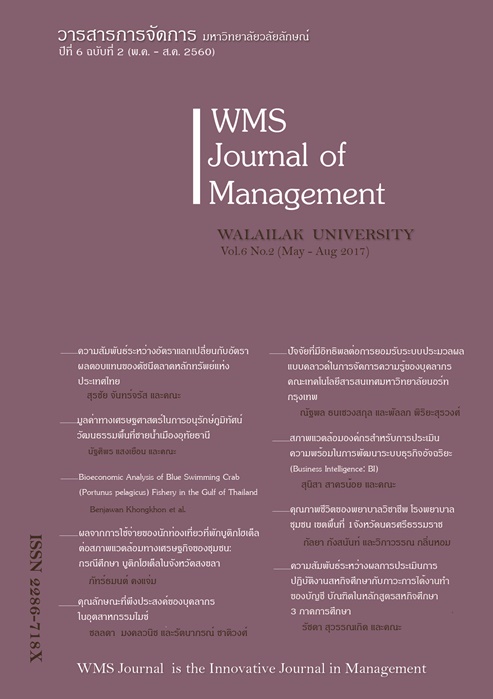Bioeconomic Analysis of Blue Swimming Crab (Portunus pelagicus) Fishery in the Gulf of Thailand
Main Article Content
Abstract
Article Details
References
Boutson, A., C. Mahasawasde, S. Mahasawasde, S. Tunkijjanukij, and T. Arimoto. (2009). Use of escape vents to improve size and species selectivity of collapsible pot for blue swimming crab Porunus pelagicus in Thailand. Fisheries Science. 75:25-33.
Clark, C. W. (1976). Mathematical Bioeconomics: the optimal management of renewable resources. New York: John Wiley & Sons.
Clark, C. W. (1990). Mathematical Bioeconomics. 2nd ed. New York: John Wiley& Sons.
Crutchfield, J. A. and Zellner, A. (1962). Economic aspects of the Pacific halibut fishery. Fish. Ind. Res., 1(1), U.S. Dept. of Interior, Washington.
Cunningham,S.,M.R.Dunn and D.Whitmarsh. (1985). Fisheries Economics: An introduction. London: Mansell Publishing Limited.
Cunningham,S.,M.R.Dunn and D.Whitmarsh. (1989). Fisheries Economics Introcuction. London: Mansell Publishing Limited. 372p.
Department of Fisheries. (1990–2012). Annual Report of Fisheries Statistics in Thailand. Sub Division of Fisheries Statistics and Information, Division of Fisheries Economics, Department of Fisheries, Bangkok.
Fishstat. (2011). FAO Fishery and Aquaculture Global Statistics. Food and Agriculture Organization of the United Nations.
Fox, W. W. (1970). An exponential surplus yield model for optimising exploited fish population. Trans. Am. Fish. Soc., 99:80-88.
Gordon, H. S. (1953). An economic approach to the optimum utilization of fishery resources. J. Fish. Res. Board Can., 10(7): 442-457.
__________. (1954). The economic theory of a common property resource: the fishery. Journal of Political Economy. 62, 124-42.
Mahfuzuddin Ahmed et at. (2007). Overfishing in the Gulf of Thailand: Policy challenges and bioeconomic analysis. Environment and Development Economics 12: 145-172. Cambridge University Press. Printed in the United Kingdom.
Nitiratsuwan, T et al. (2010). Distribution of blue swimming crab (Portunus pelagicus Linnaeus, 1758) in Trang Province. Songklanakarin J. Sci.Techno. 32(3), 207-212.
Panayotou,T. and Jetanvanich,S. (1987). The economics and management of Thai Marine Fisheries. ICLARM studies and Reviews 14. Manila: International Center for living Aquatic Resources Management, 82p.
Pella, J. J. and Tomlinson, P. K. (1969). A generalized stock production model. Bull. Inter- Amer. Trop. Tuna Comm., 13: 412-496.
Schaeffer, M. B. (1954a). Some aspects of the dynamics of populations important for the management of the commercial marine fisheries. Inter-Amer. Trop. Tuna Comm. Bull., 1(2):25-26.
Schaeffer, M. B. (1954b). Fisheries dynamics and the concept of maximum equilibrium catch. Proc. Gulf Car. Fish. Inst., 6th Annual Session.
Schaeffer, M. B. (1957). Some considerations of population dynamics and economics in relation to the management of marine fisheries. J. Fish. Res. Board Can., 14(5).
Schaeffer, M. B. (1959). Biological and economic aspects of the management of commercial marine fisheries. Transactions of the American Fisheries Society. 99:100-104.
Schatz, Richard . (1991). Economic Rent Study for the Philippine Fisheries Sector Program. Final Report.
Scott, A. D. (1955a). Natural resources: the economics of conservation. Toronto, 2nd ed. Univ. Toronto Press, McLelland Stewrat, 1972.
Scott, A. D. (1955b). The fishery: the objective of sole ownership. J. Pol. Econ., 63.
Songrak, A., Bodhisuwan, W., and Thapanand-Chaidee, T. (2013). Selectivity of traps for blue swimming crab in Trang province. Maejo Internation Journal of Science and Technology. 7, 36-42.
Sparre,P.,and Venema,S.C. (1998). Introduction to Tropical Fish Stock Assessment Part 1 : Manual. FAO. Fisheries Technical Paper. No.306.1,Rev.2. FAO,Rome. 407 p.
Taylor, B. (2013). Blue and Red Swimmer Crab Seafood Watch Report. Monterey Bay Aquarium.

